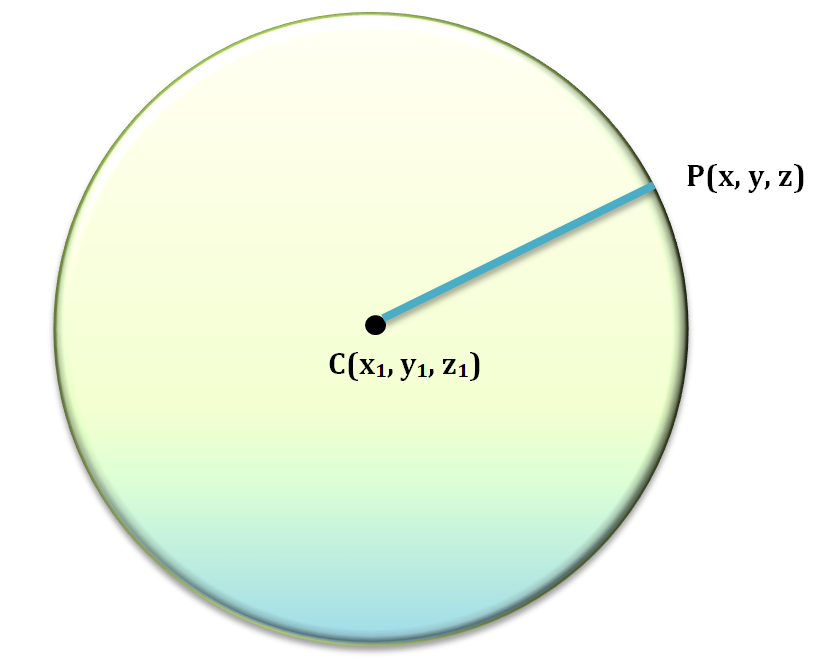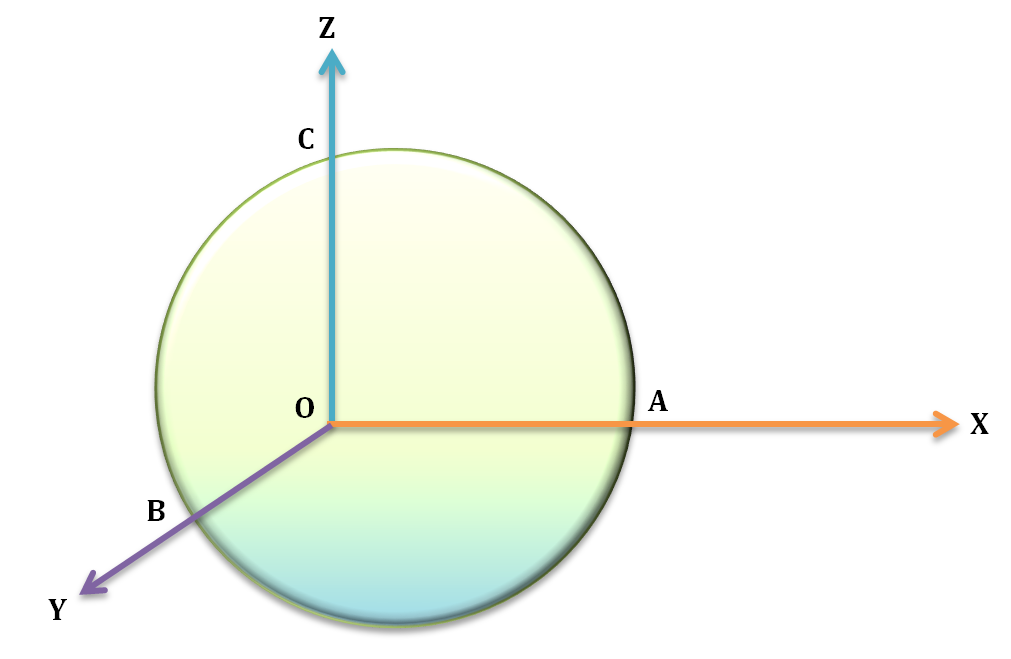Definition of Sphere
A sphere is the locus of a point which moves in the space in such a way that its distance from a fixed point is always equal to a constant. The fixed point is called the center of the sphere and the constant distance, the radius of the sphere.

Let P(x, y, z) be any point on the sphere with center at C(x1, y1, z1). If the radius of the sphere be r, then
\[C{{P}^{2}}={{r}^{2}}\]
\[\therefore \,\,{{\left( x-{{x}_{1}} \right)}^{2}}+{{\left( y-{{y}_{1}} \right)}^{2}}+{{\left( z-{{z}_{1}} \right)}^{2}}={{r}^{2}}……….\left( 1 \right)\]
This is the equation of the sphere.
If the center be at the origin, then the equation of the sphere of radius r is
\[{{x}^{2}}+{{y}^{2}}+{{z}^{2}}={{r}^{2}}……….\left( 2 \right)\]
Note 1: The equation (1) is an equation of second degree in x, y, z in which we observe that,
(i) the coefficients of x2, y2, z2 are equal
(ii) the coefficients of yz, zx, xy are all zero.
The general equation of second degree which satisfies the above two conditions is
\[a{{x}^{2}}+a{{y}^{2}}+a{{z}^{2}}+2lx+2my+2nz+d=0\]
On dividing by a (≠ 0), the general equation of the sphere becomes of the form
\[{{x}^{2}}+{{y}^{2}}+{{z}^{2}}+2gx+2fy+2hz+c=0……….\left( 3 \right)\]
This equation contains four constants g, f, h, c, and hence a sphere can be made to satisfy four independent conditions.
In particular, a sphere may be made to pass through four non-coplanar points.
The equation (3) can be put in the form (1) as
\[{{\left( x+g \right)}^{2}}+{{\left( y+f \right)}^{2}}+{{\left( z+h \right)}^{2}}={{g}^{2}}+{{f}^{2}}+{{h}^{2}}-c\]
So that the center of the sphere (3) is at \left( -g,-f,-h \right) and the radius is \sqrt{{{g}^{2}}+{{f}^{2}}+{{h}^{2}}-c}.
In order that the sphere may be real, {{g}^{2}}+{{f}^{2}}+{{h}^{2}}-c\ge 0.
Note 2: A point lies outside, on or inside a sphere according as its distance from the center of the sphere is greater than, equal to or less than the radius of the sphere.
Some Formulae on Sphere
1. Equation of the sphere is {{x}^{2}}+{{y}^{2}}+{{z}^{2}}={{r}^{2}}, center is at (0, 0, 0) and radius is r.
2. The center and radius of the sphere {{x}^{2}}+{{y}^{2}}+{{z}^{2}}+2gx+2fy+2hz+c=0 are \left( -g,-f,-h \right) and \sqrt{{{g}^{2}}+{{f}^{2}}+{{h}^{2}}-c}.
3. Sphere on the join of two points (x1, y1, z1) and (x2, y2, z2) as diameter is
\[\left( x-{{x}_{1}} \right)\left( x-{{x}_{2}} \right)+\left( y-{{y}_{1}} \right)\left( y-{{y}_{2}} \right)+\left( z-{{z}_{1}} \right)\left( z-{{z}_{2}} \right)=0\]
4. Equation of the tangent plane at (x1, y1, z1) to {{x}^{2}}+{{y}^{2}}+{{z}^{2}}={{r}^{2}} is
\[x{{x}_{1}}+y{{y}_{1}}+z{{z}_{1}}={{r}^{2}}\]
| Example 01 |
Find the equation of the sphere passing through the points (0, 0, 0), (0, 2, –1), (–1, 1, 0) and (1, 2, –3).
Solution:
Let the equation of the sphere passing through (0, 0, 0) be
\[{{x}^{2}}+{{y}^{2}}+{{z}^{2}}+2gx+2fy+2hz=0……….\left( 1 \right)\]
Since (0, 2, –1) is a point on (1), we have
\[4+1+4f-2h=0\]
\[\Rightarrow 2h=4f+5\]
Hence (1) can be written as
\[{{x}^{2}}+{{y}^{2}}+{{z}^{2}}+2gx+2fy+\left( 4f+5 \right)z=0……….\left( 2 \right)\]
Again since (–1, 1, 0) is a point on (2), we have
\[1+1-2g+2f=0\]
\[\Rightarrow 2g=2f+2\]
Hence (2) takes the form
\[{{x}^{2}}+{{y}^{2}}+{{z}^{2}}+\left( 2f+2 \right)x+2fy+\left( 4f+5 \right)z=0……….\left( 3 \right)\]
Again (1, 2, –3) is a point on (3), we have
\[1+4+9+\left( 2f+2 \right)+2f.2+\left( 4f+5 \right).\left( -3 \right)=0\]
\[\Rightarrow -6f+1=0\]
\[\Rightarrow f=\frac{1}{6}\]
\[\therefore 2g=2f+2=\frac{1}{3}+2=\frac{7}{3}\]
\[and\,\,2h=4f+5=\frac{4}{6}+5=\frac{34}{6}\]
Hence (1) takes the form
\[{{x}^{2}}+{{y}^{2}}+{{z}^{2}}+\frac{7}{3}x+\frac{2}{6}y+\frac{34}{6}z=0\]
\[\Rightarrow 6\left( {{x}^{2}}+{{y}^{2}}+{{z}^{2}} \right)+14x+2y+34z=0\]
Which is the required equation of the sphere.
| Example 02 |
Find the values of a for which the plane x+y+z=a is a tangent plane to the sphere {{x}^{2}}+{{y}^{2}}+{{z}^{2}}=27.
Solution:
The equation of the tangent plane to the given sphere at (x1, y1, z1) is
\[x{{x}_{1}}+y{{y}_{1}}+z{{z}_{1}}=27………\left( 1 \right)\]
This is identical with x+y+z=a, then
\[\frac{{{x}_{1}}}{1}=\frac{{{y}_{1}}}{1}=\frac{{{z}_{1}}}{1}=\frac{27}{a}\]
\[\therefore {{x}_{1}}=\frac{27}{a},{{y}_{1}}=\frac{27}{a},{{z}_{1}}=\frac{27}{a}\]
But (x1, y1, z1) is a point on {{x}^{2}}+{{y}^{2}}+{{z}^{2}}=27.
\[\therefore x_{1}^{2}+y_{1}^{2}+z_{1}^{2}=27\]
\[\Rightarrow {{\left( \frac{27}{a} \right)}^{2}}+{{\left( \frac{27}{a} \right)}^{2}}+{{\left( \frac{27}{a} \right)}^{2}}=27\]
\[\Rightarrow 3\times \frac{{{27}^{2}}}{{{a}^{2}}}=27\]
\[\Rightarrow {{a}^{2}}=81\]
\[\therefore \,\,a=\pm 9\]
Therefore the required values of a are ±9.
| Example 03 |
Find the equation of the sphere which passes through the origin and makes intercepts a, b, c from the co-ordinate axes.
Solution:
Let the equation of the sphere be
\[{{x}^{2}}+{{y}^{2}}+{{z}^{2}}+2gx+2fy+2hz+d=0……….\left( 1 \right)\]

Since it passes through O(0, 0, 0), A(a, 0, 0), B(0, b, 0), C(0, 0, c), therefore the co-ordinates of these points will satisfy the equation (1) successively.
\[0+0+0+0+0+0+d=0\]
\[\Rightarrow d=0\]
\[{{a}^{2}}+2ga=0\]
\[i.e.,\,2g=-a\]
\[{{b}^{2}}+2fb=0\]
\[i.e.,\,2f=-b\]
\[{{c}^{2}}+2hc=0\]
\[i.e.,\,2h=-c\]
Putting these values in (1), we get
\[{{x}^{2}}+{{y}^{2}}+{{z}^{2}}-ax-by-cz=0\]
Hence above is the required equation of the sphere.
Straight Line |
2nd Degree |


